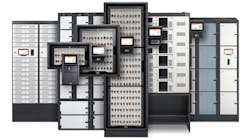AI at the Tipping Point: Analysts See Data Centers at a Crossroads of Demand, Power, and Opportunity
Two freshly released reports from CBRE and Deloitte paint a vivid portrait of a global data center industry racing against time, power constraints, and infrastructure bottlenecks.
CBRE’s Global Data Center Trends 2025 report offers a detailed snapshot of current supply-demand dynamics across key international markets, while Deloitte’s Can U.S. Infrastructure Keep Up With the U.S. Economy? goes further, projecting that power demand from AI data centers could surge more than thirtyfold by 2035 and placing that challenge squarely in the context of national strategic priorities.
Together, these reports confirm what many industry insiders already suspect: the AI era has changed the data center game, and it’s only getting started.
A Global Snapshot: CBRE Tracks Market-by-Market Shifts
CBRE’s latest report takes the pulse of the industry by examining data center trends in North America, Europe, Asia-Pacific, and Latin America. Despite a surge in new construction, a critical finding stands out: vacancy rates are falling globally even as inventories rise, a sign that AI-driven demand is soaking up capacity faster than it can be built.
Key data points include the following:
- The global weighted average vacancy rate dropped to 6.6% in Q1 2025, down from 8.7% a year ago.
- Northern Virginia added 523 MW of inventory, yet its vacancy remains an astonishingly low 0.76%.
- Paris, Frankfurt, and Santiago showed sharp declines in vacancy, pointing to constrained supply in key global hubs.
CBRE’s report underscores the prevalence of aggressive preleasing, with major AI and cloud players locking in multi-megawatt tranches of capacity before concrete has even been poured. In Northern Virginia, Phoenix, and Atlanta, this trend has led to record-high net absorption, with North America seeing a 101% year-over-year increase to 1,668.5 MW.
“Power capacity constraints are forcing aggressive preleasing and extending new construction timelines to 2027 and beyond,” the report notes. That delay opens the door for new secondary markets to surge, including Richmond, Bogotá, Johor, and Querétaro.
But with demand accelerating, cracks are showing. Even traditionally stable pricing regions are facing pressures. CBRE reports a global average pricing increase of 3.3%, with standouts like Amsterdam (+18%) and Northern Virginia (+17.6%). Latin American markets like São Paulo, however, experienced pricing drops due to increased supply and energy uncertainty.
Deloitte’s Long View: The AI Era’s Power Problem
If CBRE is the dashboard of the current market, Deloitte offers a look under the hood. And a warning light is blinking.
The Deloitte report forecasts a 30x increase in AI data center power demand, from 4 GW in 2024 to 123 GW by 2035. That growth would reshape not only the data center industry but the entire U.S. infrastructure ecosystem, from energy utilities to manufacturing and construction.
According to Deloitte:
- In 2024, AI represented just 12% of data center power demand (4 GW of 33 GW).
- By 2035, AI could represent 70% of the projected 176 GW in total data center power demand.
- Mentions of “data center” on investor calls in the manufacturing and energy sectors grew fivefold between 2023 and 2024.
This is more than just AI hype. It has the hallmarks of a structural shift. Deloitte correctly found that hyperscaler data center campuses already under construction draw hundreds of megawatts, while some of the largest new sites are approaching gigawatt-scale.
“There is an opportunity in infrastructure development to support the national strategic priorities of AI and energy dominance,” said Martin Stansbury, Principal at Deloitte & Touche LLP. “However, it is a complex undertaking.”
Shared Challenge: Power and Grid Capacity Constraints
Perhaps the most unifying thread between the CBRE and Deloitte findings is the role of power as both a limiting factor and strategic catalyst.
Deloitte’s survey of 60 data center and 60 power company executives found that 72% consider power and grid capacity constraints “very or extremely challenging.” This view echoes CBRE’s regional breakdowns, where power availability, especially in Europe and Latin America, is slowing or stalling buildouts.
In Amsterdam, no new inventory was added in the past year. In Querétaro, only 4.1 MW of net absorption occurred in Q1 due to energy limitations. Even markets like Singapore, flush with demand, struggle to add new capacity due to government controls and power provisioning delays.
CBRE’s report documents how these challenges push development toward suburban and secondary markets, where transmission capacity may be more readily available or affordable. Meanwhile, Deloitte frames these challenges as an opening for cross-sector collaboration, calling for utilities, regulators, manufacturers, and cloud operators to unite behind shared infrastructure initiatives.
Collaboration vs. Fragmentation
Deloitte highlights regulatory lag and a lack of effective partnership frameworks as a barrier to progress. While 78% of data center and 67% of power respondents believe in the importance of cooperation, only 15% and 8%, respectively, describe such cooperation as highly effective.
Among the proposed solutions:
- Technological innovation, such as better transformers and smarter grids.
- Regulatory streamlining, including faster interconnection processes.
- Public-private investment that balances innovation with ratepayer protection.
Deloitte suggests the U.S. must embrace “additive infrastructure," i.e. investments that build on existing assets while pushing for efficiency, capacity, and flexibility in a constrained grid environment.
A Trillion-Dollar Alignment
One figure speaks volumes: $1 trillion. That’s the amount both U.S. utilities and hyperscalers are expected to spend annually on AI infrastructure and power development, by 2032 and 2028 respectively.
In tandem, the tech industry plans to invest another $1 trillion in U.S. manufacturing over the next four years for supercomputers, chips, and servers. The scale and synchrony of this investment wave is unprecedented.
Yet as Deloitte warns, power companies are still navigating how to fund expansion without passing costs to consumers, while hyperscalers and cloud platforms benefit from greater investment momentum.
Conclusion: Same Story, Two Angles
CBRE and Deloitte have delivered two different but complementary perspectives on a data center industry under extraordinary pressure.
CBRE provides the detailed regional ledger: the occupancy numbers, pricing dynamics, and market trajectories that define where and how growth is happening. Deloitte, meanwhile, steps back to reveal the systemic picture: AI is far from just a new workload; it’s a power-hungry force that is redrawing the map of infrastructure, economics, and energy policy.
In short: demand is here, growth is underway, and opportunity abounds. But without bold cross-sector innovation and a rethinking of how infrastructure is planned, provisioned, and powered, the industry risks falling behind the AI revolution it helped ignite.
Coda: Commercial Real Estate’s Cautious Dance with the AI Data Center Boom
While CBRE and Deloitte focus on the structural forces shaping data center expansion - inventory shifts, AI demand, and power constraints - DLA Piper’s 2025 State of the Market Real Estate Survey offers a revealing glimpse into how the broader commercial real estate (CRE) sector is interpreting these same forces through the lens of investor sentiment.
Conducted in two waves, before and after U.S. tariff announcements, DLA Piper’s survey tracks a sharp mood shift. What began in early 2025 with a return to bullish sentiment (52% optimistic in Wave 1) reversed by May, with 66% of CRE respondents reporting bearish views in Wave 2. The turning point? Rising interest rate expectations, tariff concerns, and geopolitical unease.
Yet even amid this retreat, data centers stood out. In the Wave 1 survey, 44% of respondents identified data centers as one of the most attractive asset classes, behind only multifamily housing. That interest held steady even as other sectors, like office and foreign investment, saw confidence erode. The report notes that resilient secular trends, such as AI and digital infrastructure, continue to anchor investment interest in high-growth, high-utility sectors.
DLA Piper’s insights contrast starkly with Deloitte’s and CBRE’s granular data:
- CBRE shows data center fundamentals tightening across all regions, with low vacancy and aggressive preleasing signaling investor confidence in the asset class's growth potential, even amid constrained supply.
- Deloitte extrapolates this trend into a long-term structural shift, predicting $1 trillion in capex for utilities and hyperscalers alike, and positioning AI-driven infrastructure as a national strategic priority.
- Meanwhile, DLA Piper provides the macro pulse, revealing how broader economic conditions, as driven by tariffs, interest rates, capital availability, could challenge CRE decision-making, even in sectors like data centers that appear bulletproof on paper.
In short, where CBRE counts megawatts, and Deloitte projects gigawatts, DLA Piper counts sentiment, and that sentiment is apparently getting more cautious, even as digital infrastructure continues to shine.
The bottom line? Data centers may be an investor darling for now, but their future, as the Deloitte report warns, is entangled with factors far beyond floor space or cooling density. Tariffs, trade policy, and macroeconomics will increasingly shape not just where AI infrastructure is built, but whether it gets financed and approved in time to meet its own insatiable power demand.
Doug Adams, President and CEO, NTT Global Data Centers; Navid Chamdia, Head of Real Estate, QIA; Marc C. Ganzi, CEO, DigitalBridge; and Goodwin Gaw, Chairman, Managing Principal, Member of Investment Committee and Co-Founder, Gaw Capital discuss how next-generation data centers are evolving to meet the demands of artificial intelligence, and the critical role infrastructure and capital play in building AI’s backbone, with Bloomberg’s Joumanna Bercetche at the 2025 Qatar Economic Forum.
At Data Center Frontier, we talk the industry talk and walk the industry walk. In that spirit, DCF Staff members may occasionally use AI tools to assist with content. Elements of this article were created with help from OpenAI's GPT4.
Keep pace with the fast-moving world of data centers and cloud computing by connecting with Data Center Frontier on LinkedIn, following us on X/Twitter and Facebook, as well as on BlueSky, and signing up for our weekly newsletters using the form below.
About the Author
Matt Vincent
A B2B technology journalist and editor with more than two decades of experience, Matt Vincent is Editor in Chief of Data Center Frontier.




